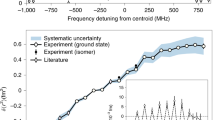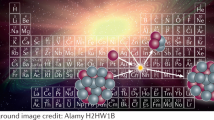Abstract
The weak force is the only fundamental interaction known to violate the symmetry with respect to spatial inversion (parity). This parity violation can be used to isolate the effects of the weak interaction in atomic systems, providing a unique, low-energy test of the standard model (see, for example, reviews1,2,3). These experiments are primarily sensitive to the weak force between the valence electrons and the nucleus, mediated by the neutral Z0 boson and dependent on the weak charge of the nucleus, Qw. The standard model parameter Qw was most precisely determined in caesium4,5 and has provided a stringent test of the standard model at low energy. The standard model also predicts a variation of Qw with the number of neutrons in the nucleus, an effect whose direct observation we are reporting here. Our studies, made on a chain of ytterbium isotopes, provide a measurement of isotopic variation in atomic parity violation, confirm the predicted standard model Qw scaling and offer information about an additional Z′ boson.
This is a preview of subscription content, access via your institution
Access options
Access Nature and 54 other Nature Portfolio journals
Get Nature+, our best-value online-access subscription
$29.99 / 30 days
cancel any time
Subscribe to this journal
Receive 12 print issues and online access
$209.00 per year
only $17.42 per issue
Buy this article
- Purchase on Springer Link
- Instant access to full article PDF
Prices may be subject to local taxes which are calculated during checkout



Similar content being viewed by others
Data availability
The data that support the findings of this study are available from the corresponding author upon reasonable request.
References
Ginges, J. S. M. & Flambaum, V. V. Violations of fundamental symmetries in atoms and tests of unification theories of elementary particles. Phys. Rep. 397, 63–154 (2004).
Roberts, B. M., Dzuba, V. A. & Flambaum, V. V. Parity and time-reversal violation in atomic systems. Annu. Rev. Nucl. Part. Sci. 65, 63–86 (2015).
Safronova, M. S. et al. Search for new physics with atoms and molecules. Rev. Mod. Phys. 90, 025008 (2018).
Wood, C. S. et al. Measurement of parity nonconservation and an anapole moment in cesium. Science 275, 1759–1763 (1997).
Dzuba, V. A., Berengut, J. C., Flambaum, V. V. & Roberts, B. Revisiting parity nonconservation in cesium. Phys. Rev. Lett. 109, 203003 (2012).
DeMille, D. Parity nonconservation in the 6s2 1S0→5d6s 3D1 transition in atomic ytterbium. Phys. Rev. Lett. 74, 4165–4168 (1995).
Porsev, S. G., Rakhlina, Yu. G. & Kozlov, M. G. Parity violation in atomic ytterbium. J. Exp. Theor. Phys. Lett. 61, 459–463 (1995).
Das, B. P. Computation of correlation effects on the parity-nonconserving electric-dipole transition in atomic ytterbium. Phys. Rev. A 56, 1635–1637 (1997).
Dzuba, V. A. & Flambaum, V. V. Calculation of parity nonconservation in neutral ytterbium. Phys. Rev. A. 83, 042514 (2011).
Tsigutkin, K. et al. Observation of a large atomic parity violation effect in ytterbium. Phys. Rev. Lett. 103, 071601 (2009).
Tsigutkin, K. et al. Parity violation in atomic ytterbium: Experimental sensitivity and systematics. Phys. Rev. A. 81, 032114 (2010).
Dzuba, V. A., Flambaum, V. V. & Khriplovich, I. B. Enhancement of P- and T-nonconserving effects in rare-earth atoms. Z. Phys. D 1, 243–245 (1986).
Fortson, E. N., Pang, Y. & Wilets, L. Nuclear-structure effects in atomic parity nonconservation. Phys. Rev. Lett. 65, 2857–2860 (1990).
Brown, B. A., Derevianko, A. & Flambaum, V. V. Calculations of the neutron skin and its effect in atomic parity violation. Phys. Rev. C 79, 035501 (2009).
Dzuba, V. A., Flambaum, V. V. & Stadnik, Y. V. Probing low-mass vector bosons with parity nonconservation and nuclear anapole moment measurements in atoms and molecules. Phys. Rev. Lett. 119, 223201 (2017).
Flambaum, V. V. & Khriplovich, I. B. P-odd nuclear forces: a source of parity violation in atoms. ZhETF 79, 1656–1663 (1980); JETP 52, 835-839 (1980).
Flambaum, V. V., Khriplovich, I. B. & Sushkov, O. P. Nuclear anapole moments. Phys. Lett. B 146, 367–369 (1984).
Haxton, W. C. & Wieman, C. E. Atomic parity nonconservation and nuclear anapole moments. Annual Rev. Nucl. Part. Sci. 51, 261–293 (2001).
Bouchiat, M. A. & Pottier, L. Optical experiments and weak interactions. Science 234, 1203–1210 (1986).
Bouchiat, M. A. & Bouchiat, C. Parity violation induced by weak neutral currents in atomic physics. J. Phys. France II 36, 493–509 (1975).
Drell, P. S. & Commins, E. D. Parity nonconservation in atomic thallium. Phys. Rev. Lett. 53, 968–971 (1984).
Antypas, D., Fabricant, A., Bougas, L., Tsigutkin, K. & Budker, D. Towards improved measurements of parity violation in atomic ytterbium. Hyperfine Interact. 238, 21 (2017).
Bouchiat, M. A., Coblentz, A., Guéna, J. & Pottier, L. Can imperfect light polarization mimic parity violation in Stark experiments on forbidden M1 transitions? J. Phys. France 42, 985–990 (1981).
Tanabashi, M. et al. Review of particle physics. Phys. Rev. D 98, 030001 (2018).
Heckel, B. R. et al. New CP-violation and preferred-frame tests with polarized electrons. Phys. Rev. Lett. 97, 021603 (2006).
Heckel, B. R. et al. Preferred-frame and CP-violation tests with polarized electrons. Phys. Rev. D 78, 092006 (2008).
Vasilakis, G., Brown, J. M., Kornack, T. W. & Romalis, M. V. Limits on new long range nuclear spin-dependent forces set with a K–3He comagnetometer. Phys. Rev. Lett. 103, 261801 (2009).
Stalnaker, J. E. et al. Dynamic Stark effect and forbidden-transition spectral line shapes. Phys. Rev. A 73, 043416 (2006).
Dounas-Frazer, D. R., Tsigutkin, K., Family, A. & Budker, D. Measurement of dynamic Stark polarizabilities by analyzing spectral lineshapes of forbidden transitions. Phys. Rev. A. 82, 062507 (2010).
Antypas, D., Fabricant, A. & Budker, D. Lineshape-asymmetry elimination in weak atomic transitions driven by an intense standing wave field. Opt. Lett. 43, 2241–2243 (2018).
Tsigutkin, K. et al. in From Parity Violation to Hadronic Structure and more (eds de Jager, K. et al) 177–183 (Springer, Berlin, Heidelberg, 2007).
Androić, D. et al. (The Jefferson Lab Qweak Collaboration) Precision measurement of the weak charge of the proton. Nature 557, 207–211 (2018).
Stalnaker, J. E., Budker, D., DeMille, D. P., Friedman, S. J. & Yashchuk, V. V. Measurement of the forbidden 6s 2 1S0→5d6s 3D1 magnetic-dipole transition amplitude in atomic ytterbium. Phys. Rev. A. 66, 031403 (2002).
Budker, D. & Stalnaker, J. E. Magnetoelectric Jones dichroism in atoms. Phys. Rev. Lett. 91, 263901 (2003).
Acknowledgements
We thank M. Safronova, M. Kozlov, S. Porsev, M. Zolotorev, A. Viatkina, L. Bougas and N. Leefer for useful discussions. A.F. is supported by the Carl Zeiss Graduate Fellowship.
Author information
Authors and Affiliations
Contributions
D.A. built the apparatus, collected and analysed data, and wrote the manuscript. A.F. contributed to the apparatus construction, took data and edited the manuscript. J.E.S. participated in studies of systematic errors, contributed to data analysis and edited the manuscript. K.T. participated in studies of systematics and data analysis. V.V.F. led the analysis of data to extract limits on Z´ boson-mediated interactions. D.B. supervised the project and edited the manuscript.
Corresponding author
Ethics declarations
Competing interests
The authors declare no competing interests.
Additional information
Publisher’s note: Springer Nature remains neutral with regard to jurisdictional claims in published maps and institutional affiliations.
Supplementary information
Supplementary information
Supplementary Figure 1 and Supplementary Table 1
Rights and permissions
About this article
Cite this article
Antypas, D., Fabricant, A., Stalnaker, J.E. et al. Isotopic variation of parity violation in atomic ytterbium. Nature Phys 15, 120–123 (2019). https://doi.org/10.1038/s41567-018-0312-8
Received:
Accepted:
Published:
Issue Date:
DOI: https://doi.org/10.1038/s41567-018-0312-8
This article is cited by
-
Constraints on exotic spin-velocity-dependent interactions
Nature Communications (2022)
-
Searching for Z′ bosons at the P2 experiment
Journal of High Energy Physics (2021)
-
Spectroscopy of short-lived radioactive molecules
Nature (2020)
-
Nuclear-spin dependent parity violation in optically trapped polyatomic molecules
Communications Physics (2019)



